EVALUASI PENERAPAN SANITASI DI TEMPAT AGROWISATA NANAS TANGKIT BARU, SUNGAI GELAM, KABUPATEN MUARO JAMBI, JAMBI TAHUN 2023
DOI:
https://doi.org/10.22373/ljee.v4i1.2809Abstract
Tangkit Pineapple Agrotourism Area is the center of pineapple fruit production centers in Jambi Province and is the largest pineapple fruit agrotourism site in Jambi. As a tourist spot for pineapple fruit production centers in Jambi, the safety and comfort of visitors must be maintained to avoid the threat of various diseases through the provision of good sanitation facilities. The study aims to determine the description of Tangkit Pineapple Agrotourism sanitation. The study used a qualitative descriptive method, using a public places sanitation inspection instrument. The variables observed were the tourist environment including clean water, public toilets, waste water disposal, waste management, counseling facilities, health facilities and fire extinguishers. Data collection used observation sheets by means of transects throughout the Tangkit Pineapple Agrotourism area. The results of observations were compared with the standards of sanitation facilities and infrastructure, and presented in descriptive form. In general, the sanitation condition of the Tangkit Pineapple Agrotourism area still does not meet the applicable requirements. Liquid and solid waste management has not been done properly. Meanwhile, health facilities and fire extinguishers as supporting facilities are also not found. These results indicate the high risk of health and safety of visitors.
Keywords: Evaluation, Sanitation, Public Places, Agrotourism.
References
Apriyanti, Rehulina, Remigius S Hari, Diana Susilowati, and Rina Widayanti. 2022. “PERENCANAAN FASILITAS KESEHATAN BERBASIS WISATA UNTUK WISATAWAN MANCANEGARA LANJUT USIA DI MADURA.” Syntax Literature: Jurnal Ilmiah Indonesia 7 (6): 7868–80.
Departemen Kesehatan R.I., 1999. Kumpulan Formulir Pemeriksaan Ke- sehatan Lingkungan (Inspeksi Sanitasi) Bidang Penyehatan Tempat-Tempat Umum, Depkes RI, Jakarta.
Depkes RI Dirjen PPM & PLP .2000. hlmn:16
Fadli, Muhammad Rijal. 2021. “Memahami Desain Metode Penelitian Kualitatif.” Humanika 21 (1): 33–54. https://doi.org/10.21831/hum.v21i1.38075.
Hera, Alicia, Fadhillah Fathan, Rizky Aranda, Sonia Wahyu, Tiara Safa, Widya Rachma, and Desy Sulistiyorini. 2022. “Inspeksi Sanitasi Obyek Wisata Kebun Raya Bogor Sanitation Inspection Bogor Tourism.” Jurnal Kesehatan Lingkungan 12 (1): 126–33. https://doi.org/10.47718/jkl.v10i2.1182.
Marinda, Dika, and Yustini Ardillah. 2019. “Implementasi Penerapan Sanitasi Tempat-Tempat Umum Pada Rekreasi Benteng Kuto Besak Kota Palembang” 18 (2): 89–97.
Rahayu, Nurma, and Agus Darmawan. 2022. “Inspeksi Sanitasi Wisata Kotamara Kota Baubau, Kabupaten Buton Provinsi Sulawesi Tenggara.” Ruwa Jurai: Jurnal Kesehatan Lingkungan 16 (3): 159. https://doi.org/10.26630/rj.v16i3.3406.
Saraswati, Layly Alinda, Indah Werdiningsih, and Purwanto Purwanto. 2016. “Evaluasi Kondisi Sarana Sanitasi Yang Disediakan Dinas Kebudayaan Dan Pariwisata Dan Tingkat Kepuasan Wisatawan Pantai Depok, Bantul, Yogyakarta, Tahun 2016.” Sanitasi: Jurnal Kesehatan Lingkungan 8 (2): 64–72. https://doi.org/10.29238/sanitasi.v8i2.739.
Suparlan. 2012. “Pengantar Pengawasan Hygiene Sanitasi Tempat-tempat umum wisata & usaha-usaha untuk umum.”Surabaya:Percetakan Dua Tujuh.
Undang–Undang Republik Indonesia No. 10 Tahun 2009 Tentang Kepariwisataan.




